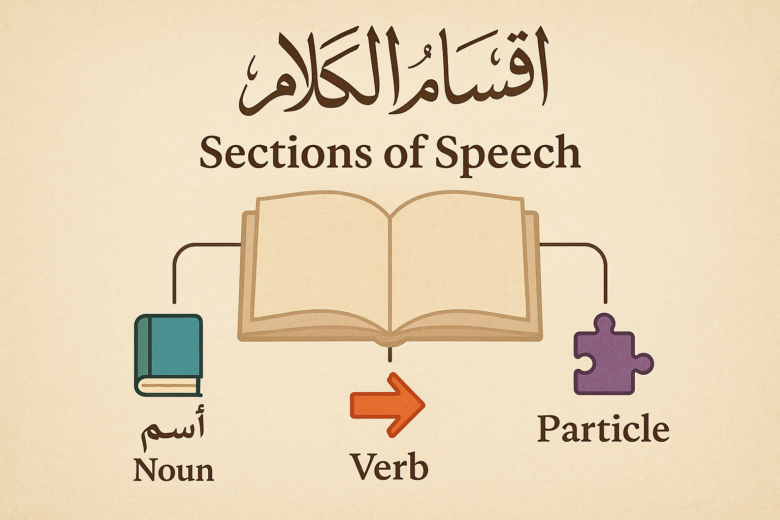🔹 Text: “And its categories are three.”
🔹 Explanation:
- The types of speech are three.
- This limitation requires evidence
💡 If someone asks:
“What is the proof that the categories of speech are three? Is there anything in the Qur’an that indicates this? Or in the Sunnah? Consensus? Analogy?”
✅ We respond:
- There is no proof from the Qur’an, Sunnah, consensus, or analogy for this.
- These sources are only required for establishing Islamic rulings, not grammar.
📌 However, scholars do have a basis for restricting the categories to three:
It is based on observation and induction (التتبع والاستقراء) of the Arabic language.
They found that Arabic speech falls into only three types:
- اسم (noun),
- فعل (verb),
- حرف (particle).
The author, due to the brevity of the book and because it’s aimed at beginners, didn’t define “noun” using a formal logical definition (رسم), but rather with its signs.
🏷️ Defining the Three Parts
- اسم (Noun): What indicates meaning by itself, without implying time.
- فعل (Verb): What indicates meaning by itself and also implies time.
- حرف (Particle): Has no meaning on its own, but its meaning becomes clear when attached to others.
📌 These definitions, though technical, are hard for beginners and have limited benefit.
So instead, we ask:
🎯 “What are the signs that a word is a noun?”
🏷️ Signs of Nouns (علامات الأسماء)
📌 The author states:
“A noun is recognized by:
- being in the genitive case (الخفض),
- tanwīn (التنوين),
- the definite article (الألف واللام),
- and particles that cause genitive (حروف الخفض).”
Let’s explain these one by one:
🔹 1. Being in the Genitive Case (الخفض / الجر)
- The Basrans say جرّ (jarr), and the Kufans say خفض (khafḍ) — both mean the same.
- If we find a word in the genitive case, it’s a noun.
📍 Example:
“مررتُ برجلٍ كريمٍ”
“I passed by a generous man.”
• “رجل” is a noun by genitive and tanwīn.
• “كريم” is confirmed a noun only by being genitive.
🔹 2. Tanwīn (التنوين)
- Tanwīn is only used with nouns.
- If a word has tanwīn, it’s a noun.
📍 Example:
“هذا رجلٌ”
“This is a man.”
✅ Noun — because of the tanwīn.
“مررتُ برجلٍ”
“I passed by a man.”
✅ Noun — it shows two signs: genitive and tanwīn.
🔹 3. The Definite Article (الألف واللام)
- The Basrans say: “أل“.
- The Kufans say: “الألف واللام“.
💡 Why the disagreement?
- The Kufans say the hamzah in “أل” is not original; it’s a connecting hamzah that drops in pronunciation, like in: “أكرمتُ الرجلَ” — the hamzah doesn’t appear in speech.
- Therefore, they don’t pronounce “أل” as a word but describe it as “alif and lām“.
📍 Example:
“الليلُ في هذه الأيام قصيرٌ”
“The night in these days is short.”
• “الليل” has the sign: alif and lām
• “قصيرٌ” has the sign: tanwīn
🔹 4. Particles that Cause Genitive (حروف الخفض)
- If a word comes after a ḥarf khafḍ, it must be a noun.
📍 Example:
“مررتُ برجلٍ” — “I passed by a man.”
The particle “بـ” causes the following word to be genitive, marking it as a noun.
🏷️ 📝 Grammar Q&A Section
❓ A man writes you a letter narrating his journey to Ḥajj. Is that considered speech (كلام)?
- Answer: ❌ No. It’s not verbal, so not counted as speech in grammar.
❓ Someone says:
“إن اجتهدتَ”
“If you strive…”
- ❌ Not considered كلام — it’s incomplete and lacks full benefit (غير مفيد).
❓ What if someone says only “إنَّ“?
- ❌ Not speech — unless it’s an actual word from moaning (أنين). Otherwise, it’s just a particle of emphasis and not meaningful by itself.
❓ A non-Arab delivers a full speech in another language?
- ❌ Not Arabic speech. Even if meaningful, it’s not considered “كلام” by grammarians.
❓ The Prophet ﷺ gestured during prayer for companions to sit?
- ❌ Not considered speech — because speech must be verbal, and gesture (إشارة) does not qualify.
🏷️ Summary of Key Points
✅ Categories of speech:
- اسم – noun
- فعل – verb
- حرف – particle (that conveys meaning)
⚠️ A letter like “م” does not count as speech, unless it conveys meaning — like “مِنْ” which indicates starting point or part of something.
🏷️ Four Signs of a Noun Recap
- Genitive case (خفض / جرّ)
- Tanwīn (تنوين)
- Alif and lām (الألف واللام)
- Preceded by ḥarf khafḍ (حروف الخفض)
🏷️ Important Notes
- “جرّ” is Basran, “خفض” is Kufan — both mean genitive.
📖 Example 1
وَلِمَنْ جَاءَ بِهِ حِمْلُ بَعِيرٍ
“And whoever brings it shall [have] the load of a camel.”
— Sūrat Yūsuf (12:72)
🖋 “بعيرٍ” (camel)
✅ Noun — contains:
- Tanwīn (تنوين)
- Genitive case (خفض)
📖 Example 2
وَاللَّيْلِ إِذَا يَغْشَى
“By the night when it covers.”
— Sūrat al-Layl (92:1)
🖋 “اللَّيْلِ” (the night)
✅ Noun — contains:
- Alif and lām (الألف واللام)
- Genitive case (خفض)
⚠️ Tanwīn and Alif-lām NEVER combine:
- You will never see a word with both tanwīn and “أل”.
✅ But three out of four signs may appear together.

